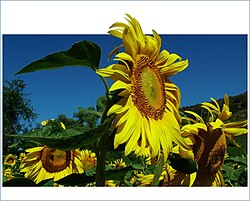Electrophysiology
Plants have a variety of methods of delivering electrical signals. The four commonly recognized propagation methods include action potentials (APs), variation potentials (VPs), local electric potentials (LEPs), and systemic potentials (SPs) [23] [24] [25]
Although plant cells are not neurons, they can be electrically excitable and can display rapid electrical responses in the form of APs to environmental stimuli. APs allow for the movement of signaling ions and molecules from the pre-potential cell to the post-potential cell(s). These electrophysiological signals are constituted by gradient fluxes of ions such as H+, K+, Cl−, Na+, and Ca2+ but it is also thought that other electrically charge ions such as Fe3+, Al3+, Mg2+, Zn2+, Mn2+, and Hg2+ may also play a role in downstream outputs. [26] The maintenance of each ions electrochemical gradient is vital in the health of the cell in that if the cell would ever reach equilibrium with its environment, it is dead. [27] [28] This dead state can be due to a variety of reasons such as ion channel blocking or membrane puncturing.
These electrophysiological ions bind to receptors on the receiving cell causing downstream effects result from one or a combination of molecules present. This means of transferring information and activating physiological responses via a signaling molecule system has been found to be faster and more frequent in the presence of APs. [26]
These action potentials can influence processes such as actin-based cytoplasmic streaming, plant organ movements, wound responses, respiration, photosynthesis, and flowering. [29] [30] [31] [32] These electrical responses can cause the synthesis of numerous organic molecules, including ones that act as neuroactive substances in other organisms such as calcium ions. [33]
The ion flux across cells also influence the movement of other molecules and solutes. This changes the osmotic gradient of the cell, resulting in changes to turgor pressure in plant cells by water and solute flux across cell membranes. These variations are vital for nutrient uptake, growth, many types of movements (tropisms and nastic movements) among other basic plant physiology and behavior. [34] [35] (Higinbotham 1973; Scott 2008; Segal 2016).
Thus, plants achieve behavioural responses in environmental, communicative, and ecological contexts.
Signal perception
Plant behavior is mediated by phytochromes, kinins, hormones, antibiotic or other chemical release, changes of water and chemical transport, and other means.
Plants have many strategies to fight off pests. For example, they can produce a slew of different chemical toxins against predators and parasites or they can induce rapid cell death to prevent the spread of infectious agents. Plants can also respond to volatile signals produced by other plants. [36] [37] Jasmonate levels also increase rapidly in response to mechanical perturbations such as tendril coiling. [38]
In plants, the mechanism responsible for adaptation is signal transduction. [39] [40] [41] [42] Adaptive responses include:
- Active foraging for light and nutrients. They do this by changing their architecture, e.g. branch growth and direction, physiology, and phenotype. [43] [44] [45]
- Leaves and branches being positioned and oriented in response to a light source. [43] [46]
- Detecting soil volume and adapting growth accordingly, independently of nutrient availability. [47] [48] [49]
- Defending against herbivores.




